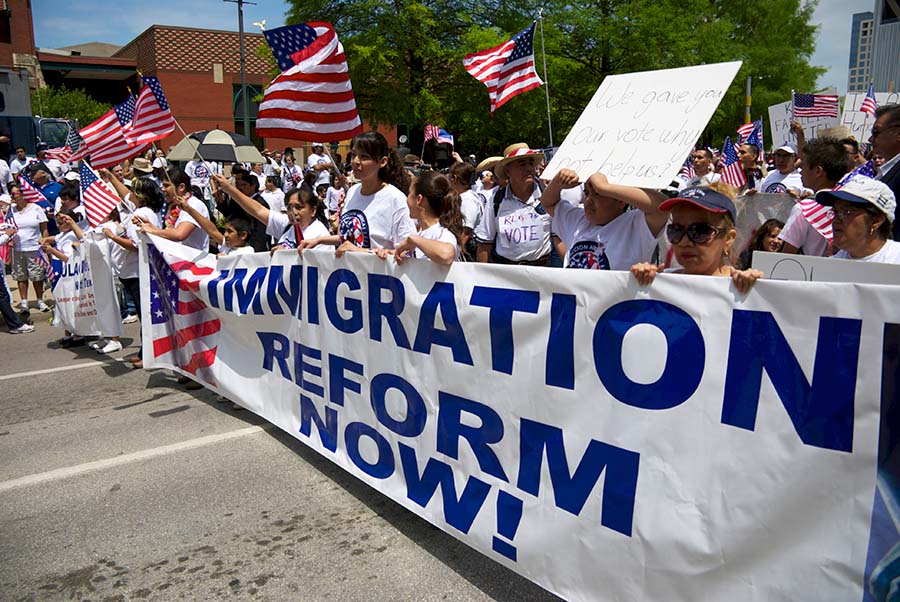Nearly everyone agrees that immigration is a problem, but there isn’t widespread agreement on how to solve it. That isn’t surprising, given that the current refugee crisis, the tragic limbo of the DREAMers and concerns over border security have interwoven with other aspects of political life like labor, culture, and logistics to create a quintessential “wicked” policy problem.
Cold War, Immigration Style
Migration to the U.S. has been soaring since the start of the pandemic, with U.S. Customs and Border Protection reporting migrant encounters spiking rapidly since COVID’s onset. Many of the problems are compounded by the vast number asylum seekers who have pending cases that are often backlogged.
There was a period during which the Biden administration appeared to be minimizing the situation, much to the consternation of Republicans and Democrats in border states. There was also a time in which the Biden administration tried to eliminate the Trump era Title 42 policy, which allows border patrol officials to eject migrants immediately on the basis of protecting public health, the lapsing of which the Supreme Court has temporarily blocked.
In an era in which of hyper-partisan rhetoric, there are political entrepreneurs who have used this situation to their optical advantage. Texas and Florida governors Abbott and DeSantis did just that when they flew migrants to Martha’s Vineyard, New York, and Washington, adding another notch to their rhetorical totem of the Democratic party being run by liberal coastal elites whom they claim only superficially support sanctuary cities.
However grotesque to some, these moves may have served their political purpose while potentially putting pressure on the Biden administration to do more about the crises. After all, Biden did recently visit the border for the first time and proposed policies to help mitigate the quandary in part by continuing to utilize Title 42, working with Mexico to absorb more migrants, and beefing up border security.
The President of Immigration Legislation

Compared to recent decades, much of immigration policy in the 20th century seemed to be primarily bipartisan and updated quite regularly, but in the 1990s there was more pushback on immigrant-friendly policies. Later, after 9/11, there was an extreme focus on border security with no major legislative overhaul of immigration policy.
Into the void stepped the president, a reality aligned with the broader Washington trend of the executive branch taking responsibility for legislative agenda setting and policy making instead of the legislature, whose members have been all too content with not having to build political alliances or take the political risk of formulating policy they’d have to defend in a reelection campaign. This situation is in line with what immigration scholar Roberto Suro deems “immigration federalism.”
This concept represents a condition in which states and localities will feel compelled to make their own immigration policies given federal inaction. Examples include California’s Proposition 187 in the 1990s and Arizona’s more recent SB 1070. While federalism may work for the states on a variety of policy fronts, it’s unclear how a patchwork system of immigration laws throughout the 50 states will lead to a coherent immigration system in which we accept a healthy flow of immigrants and refugees while maintaining a safe and secure border.
Potential for Bipartisan Immigration Reform
The immigration debate, then, contains a Russian nesting doll of subproblems, from refugees and asylum seekers, to people living here illegally, and to concerns over border security. Yet there is the real potential for increasing bipartisanship, with reports of Texas Republican Senator John Cornyn aiming to lead congressional efforts at cross-aisle reform, and even taking a tour of the southern border with a few Democrats.
Any such compromise would be historic, as the last time there was a significant bipartisan immigration deal was the 1986 Reagan Amnesty bill that rendered it illegal to hire undocumented immigrants while also providing amnesty to millions of immigrants here without documents. Republicans have a narrow majority in the House, with a few seats that are in moderate districts, which means that they might have political capital to gain by forging such an agreement.
It’s possible that the GOP could get their wishes on enforcement, which would play to their base. Democrats could make some gains in terms of a path to citizenship and humanitarian-focused measures as well. Plus, there’s more urgency now, as our rapidly-aging boomer population depends on Social Security and Medicare yet doesn’t have the younger population boom to support it as in past generations. Younger immigrants could help in that area.
But the conservative wing of the GOP is still robust, and with their juicing of Kevin McCarthy during the speakership-vote drama, the rhetoric and bravado are here to say. This is partially Democrats’ fault, as they have often supported MAGA candidates in GOP primaries and have not exactly established clear messaging and goals on immigration themselves.
In the end, politicians in this current congressional milieu have little incentive to risk taking on a piece of legislation that could end up getting muddled and that they’d potentially have to defend during their primary. It will come down to political expediency and the thing congress members emphasize over everything else—reelection.












